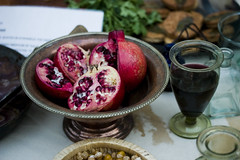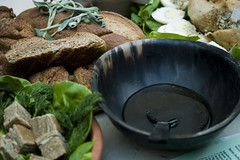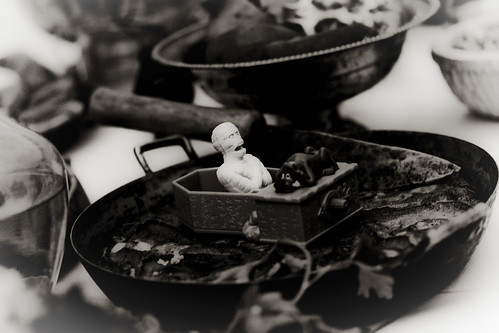 Nowadays nobody could imagine Italian cuisine without tomatoes, aubergine, potatoes, maize or pasta as we know it today. The ancient Romans had none of those ingredients available to them. Then what did they eat (besides flamingo)? I visited the ‘Feasting’ event at the British Museum to find out.
Nowadays nobody could imagine Italian cuisine without tomatoes, aubergine, potatoes, maize or pasta as we know it today. The ancient Romans had none of those ingredients available to them. Then what did they eat (besides flamingo)? I visited the ‘Feasting’ event at the British Museum to find out.
In the early years of the ancient kingdom of Rome, dining habits were quite alike for all Romans, rich or poor: breakfast (or ientaculum) in the morning, a small lunch at noon and the main meal of the day, the cena, in the evening. Barely any food was roasted; instead the food was either boiled or fried in olive oil.
Then at least for the rich Greek culture started to influence the dishes as well as dining etiquette, and by the time the Roman Empire was set in stone Roman cooks had access to a wealth of exotic ingredients and recipes.
Some of these recipes were preserved as the ‘Apicius’, a collection thought to have been assembled around the 5th century AD. Additional information comes from Cato’s tips on preparing farm products, Petronius gave satirical descriptions of a Roman feast and various other historical sources mentioning Roman food, such as the Vindolanda tablets. Less conventional sources are mosaics that once adorned the villas of the wealthy (there’s a lovely one with fish dishes in the British Museum) and food remains found at excavations, notably thethermopolia (Roman snack bars) at Pompeii.
Ancient Roman Recipies
The recipes found in the Apicius are aimed at the wealthiest classes with exotic ingredients (even for an empire as vast as the Roman) and manydifferentsauces (such as the famous, garum, made from fermented fish intestines yikes). The Romans loved sweets andoften used large amountsof honey.(Honey might evenhave been used as a ‘biological weapon’ against a Roman army led by Pompey the Great.)
More photographs of the event (and food) are available in this Flickr set.

Pork was the most popular meat, with beef only mentioned occasionally in recipes. Seafood oysters were bred on a grand scale was popular as well. Poultry was often stuffed (consult the Apicius on how to handle ‘smelly’ poultry) and on special occasions birds like peacocks, swans and even flamingos were eaten. The Romans already figured out how to force-fed geese, making fois-gras as much of a delicacy as it is today.
There was a large choice of vegetables asparagus, cardoon (a sort of artichoke), leek, radish, cabbage, cucumbers,lettuce, endives, parsnip, lentils, pees and chick-peas. Fruits were also on offer, as were nuts.
Roman Influence on the British Diet – Definitely an Improvement
What did this mean for British cooking? When the Romans came to Britain in 43AD they brought with them garlic, leek, peas, onions and many other vegetables and herbs. Meat-lovers nor hunters should ever ask ‘what did the Romans do for us?’ – they introduced many new breeds of animals: chickens, rabbits, pheasants, guinea fowl, the brown hare and possibly even rabbits. Even the poor Britons gained with an upgrade of bread and the import of more productive grains. And let us not forget the most important Roman export product of all: they brought us wine!
Roman Feasting at the British Museum
A health and safety license is needed to feed the public, so no tasting of the Roman food was allowed at the ‘Feasting’. Sadly, as the cooking by ladies from the Vicus re-enactment society looked delicious, and I wouldn’t have minded taking a bit out of some of the cookies, or trying the ancient bread.
Health and safety regulations care nothing of feeding the (already) dead, so MacMummy bravely took a dive into the ‘patina de piris’ (or patina of pears), which he seemed to enjoy immensely. Strange to me, as the recipe did seem a bit odd: Core and boil the pears, pound them with pepper, cumin, honey, passum, liquamen, and a little oil. Add eggs to make a patina, sprinkle with pepper and serve. This does mean combining pears with eggs and salty fish sauce. Not quite sure about that!
I plan to try out one of the more conventional Apicius recipes this weekend: Fresh mushrooms are stewed in reduced wine with a bunch of green coriander, which must be removed before serving. I know I chose one of the easiest ones. Even on Heritage Key (normally not that culinary oriented) we have more ‘advanced’ Prehistoric and Roman recipes available.But compared to the friendly Vicus re-enactment ladies I’m just a novice ‘ancient Roman’ cook. Surely nothing can go wrong with this one, and food poisoning won’t be on the menu. Right?
The ‘Roman Feast’ at the British Museum was part ofthe event ‘AHistory of the World in 100 Objects Evening: Feasting’. Other activities included the screening of sci-fi classic Soylent Green (surely, for good appetite), object handling and storytelling sessions. Next up on my ancient events calendar is – hopefully – a trip to the ‘Danube’ exhibition at Oxford’s Ashmolean this bank holiday weekend.
